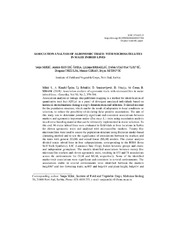Prikaz osnovnih podataka o dokumentu
Association analysis of agronomic traits with microsatellites in maize inbred lines
| dc.creator | Mikić, Sanja | |
| dc.creator | Kondić-Špika, Ankica | |
| dc.creator | Brbaklić, Ljiljana | |
| dc.creator | Stanisavljević, Dušan | |
| dc.creator | Trkulja, Dragana | |
| dc.creator | Ćeran, Marina | |
| dc.creator | Mitrović, Bojan | |
| dc.date.accessioned | 2021-04-26T19:39:19Z | |
| dc.date.available | 2021-04-26T19:39:19Z | |
| dc.date.issued | 2018 | |
| dc.identifier.issn | 0534-0012 | |
| dc.identifier.uri | http://fiver.ifvcns.rs/handle/123456789/1778 | |
| dc.description.abstract | Association analysis or linkage disequilibrium mapping is a method for identification of quantitative trait loci (QTLs) in a panel of divergent unrelated individuals based on historical recombinations during a crop's domestication and selection. It should account for the population structure, which can be the result of adaptation to local conditions or selection, to reduce the possibility of declaring false-positive associations. The aim of this study was to determine potentially significant and consistent associations between markers and agronomic important maize (Zea mays L.) traits using association analysis in a diverse breeding material that can be ultimately implemented in maize selection. To this end, 96 maize inbred lines were evaluated in field trials at three locations in Serbia for eleven agronomic traits and analysed with microsatellite markers. Twenty five microsatellites were used to assess the population structure using Bayesian model-based clustering method and to test the significance of associations between the markers and the traits with general (GLM) and mixed linear (MLM) models. The cluster analysis divided maize inbred lines in four subpopulations, corresponding to the BSSS (Iowa Stiff Stalk Synthetic), LSC (Lancaster Sure Crop), Iodent heterotic groups and exotic and independent germplasm. The models identified associations between twenty five microsatellite markers and eleven agronomic traits, resulting in 133 and 71 associations across the environments for GLM and MLM, respectively. Some of the identified marker-trait associations were significant and consistent in several environments. The associations stable in several environments were identified between the markers bnlg 1067 and two flowering traits; nc005 and bnlg434 and plant height, bnlg434 and ear height; bnlg1643 and umc1127 and leaf number, bnlg1360 and ear diameter; umc1019 and umc1506 and number of rows per ear; bnlg2305 and bnlg1451 and ear length, and between bnlg1175 and thousand-kernel weight. The results of this study indicate that these microsatellites could be used in marker-assisted selection of inbred lines, after validation of the marker-trait associations and testing combining abilities of the inbreds during hybrid development. | en |
| dc.publisher | Društvo genetičara Srbije, Beograd | |
| dc.relation | info:eu-repo/grantAgreement/MESTD/Technological Development (TD or TR)/31073/RS// | |
| dc.rights | openAccess | |
| dc.rights.uri | https://creativecommons.org/licenses/by-nc-nd/4.0/ | |
| dc.source | Genetika-Belgrade | |
| dc.subject | association mapping | en |
| dc.subject | microsatellites | en |
| dc.subject | yield components | en |
| dc.subject | Zea mays L. | en |
| dc.title | Association analysis of agronomic traits with microsatellites in maize inbred lines | en |
| dc.type | article | |
| dc.rights.license | BY-NC-ND | |
| dc.citation.epage | 394 | |
| dc.citation.issue | 2 | |
| dc.citation.other | 50(2): 379-394 | |
| dc.citation.rank | M23 | |
| dc.citation.spage | 379 | |
| dc.citation.volume | 50 | |
| dc.identifier.doi | 10.2298/GENSR1802379M | |
| dc.identifier.fulltext | http://fiver.ifvcns.rs/bitstream/id/700/1775.pdf | |
| dc.identifier.scopus | 2-s2.0-85056230857 | |
| dc.identifier.wos | 000442685800004 | |
| dc.type.version | publishedVersion |


